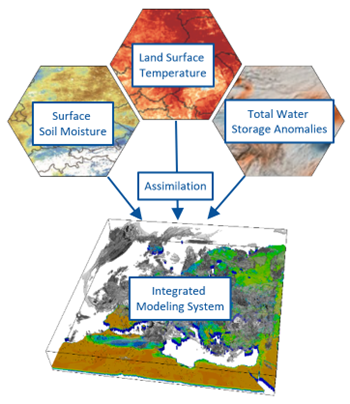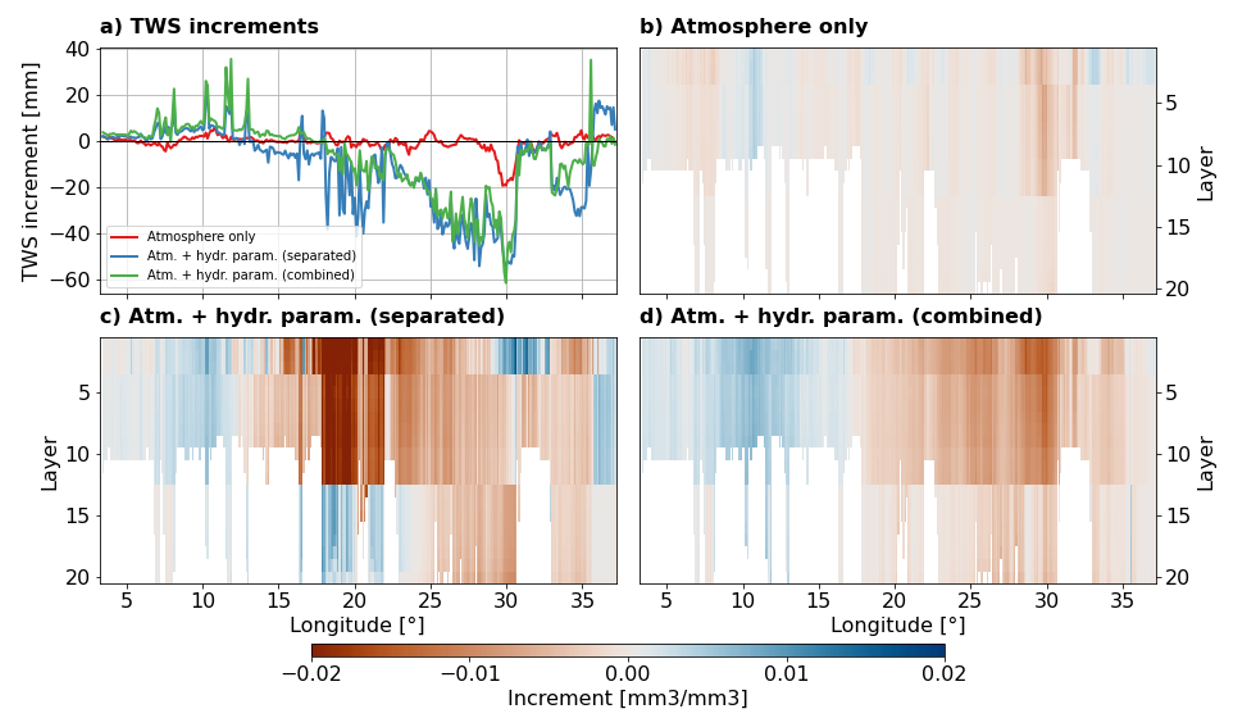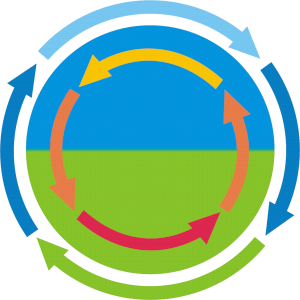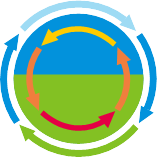C01
Land surface and sub-surface data assimilation
Dr. Anne Springer
University of Bonn | +49 228 73-6149 |
Dr. Carsten Montzka
Forschungszentrum Jülich | +49 2461 613289 |
Summary
In C01 we will develop a coupled multi-scale, multi-source data assimilation (DA) system at the continental scale, where remotely sensed surface soil moisture, total water storage changes from the GRACE/-FO missions and land surface temperature data will constrain a coupled reanalysis from groundwater to the land surface. We will evaluate to what extent the reanalysis exhibits skill to represent observed trends, reproduce interannual variability, and to simulate extreme events. A special focus is laid on investigating strategies to correct for anthropogenic impacts on the hydrological system (irrigation, groundwater abstraction) through DA.
Graphical summary

Contribution to the CRC
With respect to the CRC’s central hypothesis that human land management, land and water use changes have modified the regional atmospheric circulation and related water transports, we will add the related observations (e.g., soil moisture and land surface temperature for irrigation, total water storage anomalies for groundwater abstraction) to the central modeling system TSMP. This information is a prerequisite to adequately investigate the human role in the Eurasian climate system. To a certain extent, we are also able to support the formulation of criteria for sustainable trajectories by a differentiation between open loop simulations (the natural case) and observations (the reality case including human activities). Therefore, C01 adds knowledge with respect to all water balance equations, especially to evapotranspiration, runoff, as well as sinks and sources of terrestrial water fluxes.
Approach
We start from the central scientific hypothesis of this sub-project that surface soil moisture, total water storage anomalies and land surface temperature observations are useful to constrain coupled reanalyses from groundwater via the land surface to the lower atmosphere. Here, we focus on the land surface DA system at the continental scale and tune it regarding ensemble spread, mismatch between the measurement and model grid scale, possible bias correction procedures, and the choice of DA configurations addressing localization and inflation. This tuning procedure involves the analysis of a large amount of output data. In this project, we develop a multi-scale, multi-source Ensemble Kalman Filter DA system for the whole Eurasian continent for the time span 2002 - 2024 at a spatial resolution of 12 km. The DA system is based on the land surface component eCLM of the TSMP-PDAF modeling framework using as external atmospheric forcing data the ERA5 reanalysis.
Main results in 2022 and 2023
- We set up our data assimilation (DA) framework over the Europe using the TSMP land surface component eCLM and the parallel data assimilation framework PDAF. We prepared atmospheric forcings in cooperation with C04 and performed a spin-up for our model.
- We generated an ensemble of model runs by perturbing atmospheric forcings and land surface properties.
- We established a validating data base including a number of in-situ and remotely sensed variables over Europe for validating different variables modeled by eCLM. Additionally we implemented a validation toolbox that is also provided to other DETECT projects.
- Pittayuth Yoosiri from Brown university visited Yorck Ewerdwalbesloh in the context of the RISE program and contributed significantly to the validation toolbox.
- We worked on generating a consistent long-term surface soil moisture data set based on AMSR-E/2, ASCAT and deep learning, which is a prerequisite to avoid biases in the land surface reanalysis.
- The DA framework was extended for a first version of the GRACE observation operator and update step (Figure 1).
- Conference presentations (selected):
- Contribution Yorck Ewerdwalbesloh (28th General Assembly of the International Union of Geodesy and Geophysics (IUGG), Berlin, July 2023): Insights from GRACE data assimilation in the presence of heatwaves using two different hydrological models over Europe
- Contribution by Visakh Sivaprasad (28th General Assembly of the International Union of Geodesy and Geophysics (IUGG), Berlin, July 2023): Choosing the best preprocessing method for soil moisture data assimilation (https://doi.org/10.57757/IUGG23-2331)
- Presentation by Jürgen Kusche (American Geophyscical Union (AGU) fall meeting, San Francisco, December 2023): Assimilating gravity mission data into hydrological and land surface models (https://agu.confex.com/agu/fm23/meetingapp.cgi/Paper/1279468)

Figure 1: Total water storage changes in the Dnipro catchment area. The red bars show the increments that are added to or subtracted from the total water storage in each month during assimilation.
Main results in 2024
- We investigated the role of ensemble size in the DA framework and found 50 ensemble members to be an appropriate choice.
- We investigated the role of state vector set up and different methods for generating the model ensemble (Figure 2).
- We implemented and tested the SSM assimilation.
- We compared our C01 model simulations to simulations performed by other projects (https://doi.org/10.5194/egusphere-egu25-15914).
- Brian Kao from Brown university visited Yorck Ewerdwalbesloh in the context of the RISE program and analyzed our model simulations with respect to the representation on droughts.
- We contributed to the DETECT workshop on assimilating GRACE/-FO data into land surface and hydrological models (https://sfb1502.de/news-events/events/events-archive/grace-fo-workshop-org)
- Outreach activities: We presented the DETECT project at the Girl’s day of Bonn university in April 2024 and at the 5th Dr. Hans Riegel Academy in September.
- Conference presentations (selected):
- Contribution by Yorck Ewerdwalbesloh (European Geophysical Union (EGU) General Assembly, Vienna, April 2024): The Impact of GRACE Data Assimilation on Water Storage Dynamics in CLM3.5 and CLM5 (https://doi.org/10.5194/egusphere-egu24-10340)

Figure 2: Impact of different perturbation strategies on the DA increments for 07/2003 along a transect across Europe at ~44° North. a) TWS increments. Increments in volumetric soil water when b) perturbing only the atmosphere, c) perturbing atmosphere and additionally mineral hydraulic parameters and organic matter separately, d) perturbing atmosphere and additionally mineral hydraulic parameters and organic matter in a consistent way.
Main results in 2025
- We performed eCLM simulations with static versus transient land use and land cover data with and without irrigation in order to contribute to the human impact analysis.
- We analysed the impact of localization and inflation in our DA framework.
- We integrated our new codes into the main branches of the TSMP framework.
- We analysed the assimilation increments together with irrigation data from project B05 to determine human impacts on the water cycle.
- We adapted the TSMP-PDAF modeling framework to the Observation Module Infrastructure (OMI) interface in order to enable efficient assimilation of different observation types.
- We performed first simultaneous assimilation experiments with TWS and SSM.
- We performed first assimilation experiments with land surface temperature.
- Outreach activities:
- We presented the DETECT project at the Girl’s day of Bonn university in April 2025.
- We create a video on our SSM data set (add link!)
- We wrote a blog article: https://www.globalwaterstorage.info/en/satellite-gravimetry-improves-land-surface-model-simulations
- Conference presentations (selected):
- Contribution by Yorck Ewerdwalbesloh (ESA Living Planet Symposium, Vienna, June 2025): How can GRACE/-FO data assimilation enhance our understanding of anthropogenic effects on the hydrological system in Europe?
- Contribution by Visakh Sivaprasad (IEEE International Geoscience and Remote Sensing Symposium, Brisbane, August 2025): Evaluating the Role of Preprocessing in AMSR-E/2 Soil Moisture Data Assimilation
- We published a paper on the continuous AMSR-E/2 soil moisture time series (https://doi.org/10.1109/JSTARS.2025.3557956).
- We published a paper on a combination of DA with machine learning for forecasting terrestrial water storage and its compartments (https://doi.org/10.1029/2024WR037926).
- We published a paper on the visibility of the 2021 Western Europe flood event in satellite gravimetry (https://doi.org/10.1029/2024JD042190)
- We contributed to a paper on the benefit of future satellite gravimetry missions for Earth science applications (https://doi.org/10.1093/gji/ggaf195)
- We lead an international review paper on best practices and future directions in Assimilating GRACE/-FO terrestrial water storage data into numerical models (https://doi.org/10.5194/egusphere-2025-2058), under review

